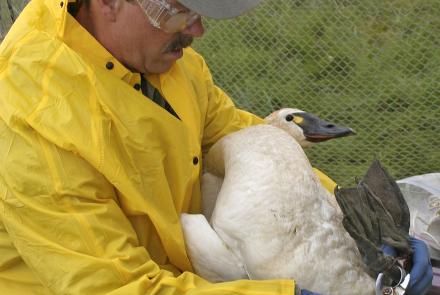Why All the Harping About HAARP?
There are a lot of things I miss about working inside the Geophysical Institute this time of year, but one void in my work routine is that I'm missing calls about HAARP on the Geophysical Institute's information line.
I referred most of the calls about HAARP, the High-frequency Active Auroral Research Program, to John Heckscher, the HAARP program manager at Hanscom Air Force Base in Massachusetts. Before I began the pipeline hike, I gave Heckscher a call to learn more about the controversial project, which is located near Gakona, about 11 miles from the Richardson Highway on the Tok cut-off road. As of this summer, HAARP consists of high-frequency transmitters that send signals from 48 antennas on top of 72-foot posts. The antenna field covers about five acres. When completed, HAARP will be expanded to 180 antennas and 33 acres no earlier than the year 2002. The purpose of HAARP is not to control weather or brain functions, Heckscher said. HAARP is a tool researchers can use to heat a patch of the ionosphere to make it act like a giant antenna. The ionosphere is a layer of Earth's atmosphere that exists from about 50 miles above the ground to 500 miles out. Home to the Aurora Borealis, the ionosphere contains both positively and negatively charged atomic particles called ions and electrons.
When HAARP is activated, the antennas simultaneously transmit high-frequency radio waves in a narrow beam. Aimed by the alignment of the antennas, the radio waves travel upward and reach the ionosphere in a roughly circular pattern that can cover 6 to 12 miles.
With this beam of high-frequency radiation, researchers can change a small portion of the electrojet---the natural currents along the auroral curtain of about one million amperes. By changing the intensity of the electrojet, researchers are able to use the ionosphere to create extremely low-frequency (ELF) radio waves. Geophysical Institute Director Syun Akasofu says that without a device such as HAARP, an antenna hundreds of miles long would be needed to broadcast in this frequency range. HAARP can effectively turn the aurora into such an antenna. Because ELF radio waves can penetrate into the ocean, submarines won't have to climb to the surface to receive radio signals. ELF waves also can propagate around Earth, making long-distance communication easy. ELF signals deeply penetrate into Earth as well as ocean, a characteristic with other possible applications. By using a receiver to monitor the waves as they bounce back from objects below Earth's surface, it may be possible to tell if tunnels or hidden underground storage areas exist in enemy territory. This is the same technique geologists have used for many years to explore for underground mineral and oil deposits.
Is HAARP dangerous? Well, HAARP signals are one million times less dangerous than government-approved safety levels for any electrical signal. HAARP's transmitter currently has a power of 1/3 megawatt, which might be boosted to 3 megawatts in a few years, Heckscher said.
He compared HAARP's effect on the vast ionosphere to the warming that would be experienced by the whole Copper River if you dipped in a small electric coil of the type used to warm one single cup of coffee. This is why Akasofu describes rumors he's heard circulating about HAARP as dangerous to people or the environment as pure science fiction. HAARP could present a potential danger to electronic equipment in aircraft that is flying overhead when the transmitter is turned on, but there are safety precautions against that. HAARP operators notify the Federal Aviation Administration with the HAARP transmission schedule and engineers are installing an aircraft-detection radar at HAARP to further ensure the safety of overflying aircraft. This same procedure is followed when rockets are launched from Poker Flat Research Range into the upper atmosphere.




